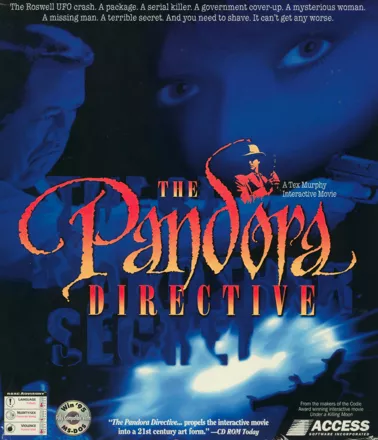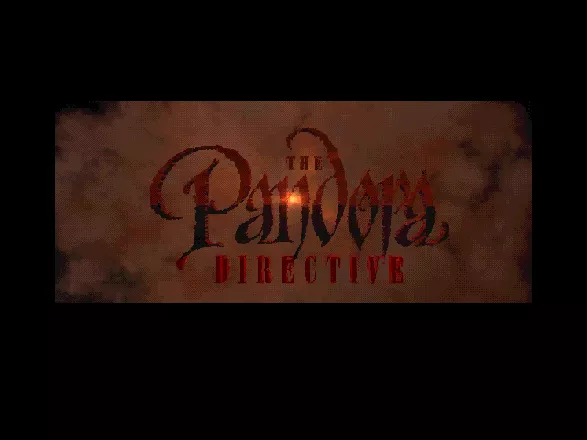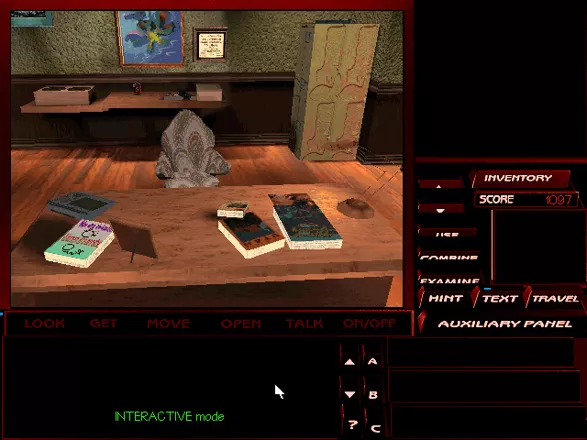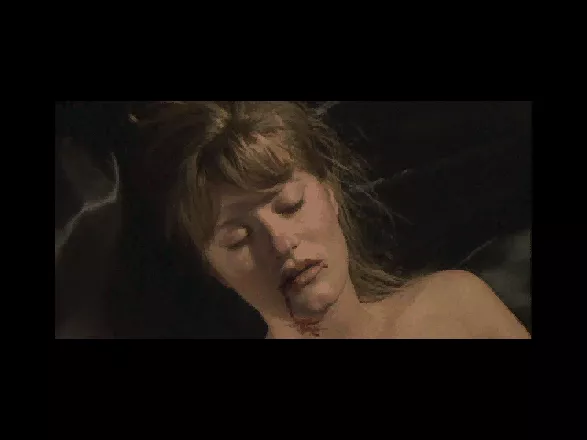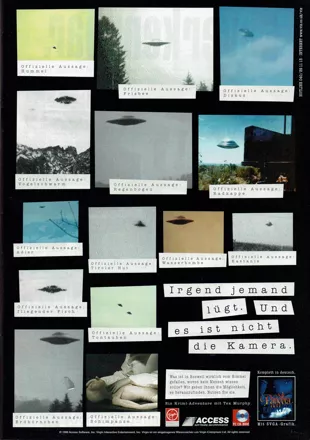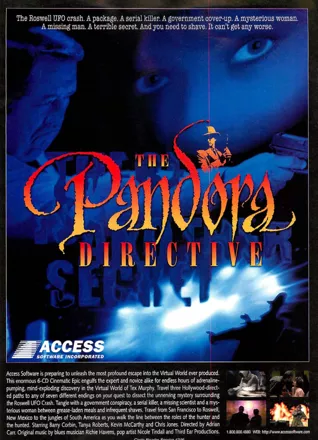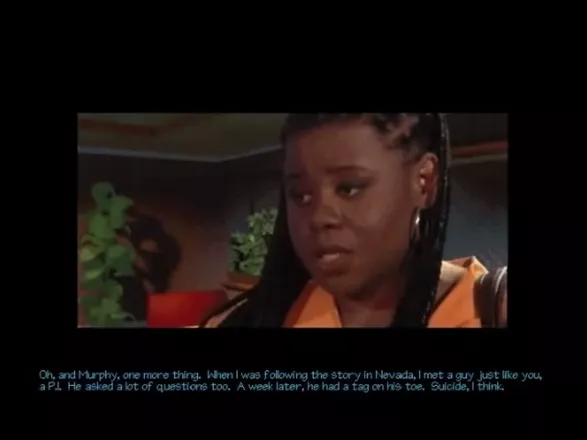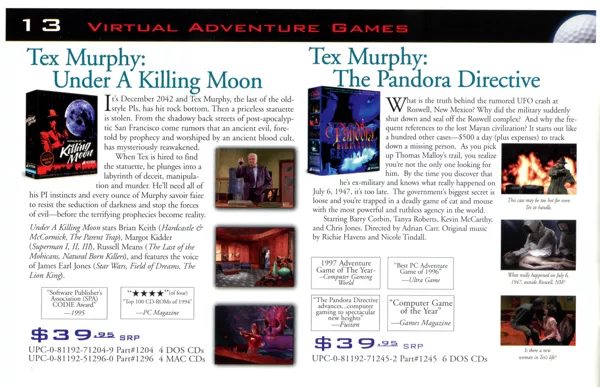The Pandora Directive
Description official descriptions
Welcome to San Francisco of the future - a strange megalopolis with a post-apocalyptic feel, where ordinary humans co-exist with mutants - the result of radioactivity. In this city is also the office of Tex Murphy, a lonely private investigator, kind-hearted, yet bitterly ironic. He is hired to investigate the disappearance of a scientist named Thomas Malloy. A series of murders occurs at that time, and before long Tex finds himself involved in a complex conspiracy of political intrigues and shocking scientific discoveries.
The Pandora Directive is a sequel to Under A Killing Moon, utilizing the same 3D engine, real actors, and gameplay system. The player can physically explore the game world, looking at objects from different angles, zooming in, etc. It is necessary to talk to many people about various topics, and also solve some complex puzzles. The game provides a built-in hint system for the puzzles, but the player does not get any points for solving them if he opts to use it.
The game introduces a new gameplay element: Tex has three kinds of answers at his disposal during some important dialogues. Depending on what kind of approach the player chooses for Tex (especially in conversations with his sweetheart Chelsee), subsequent plot events will be influenced, eventually leading to one of the six different endings.
Groups +
Screenshots
Promos
Videos
Add Trailer or Gameplay Video +1 point
See any errors or missing info for this game?
You can submit a correction, contribute trivia, add to a game group, add a related site or alternate title.
Credits (DOS version)
76 People (72 developers, 4 thanks) · View all
| Starring |
|
| Co-Starring | |
| Movie Sequences Edited & Directed by | |
| Interactive Movie Produced by | |
| Designed by | |
| [ full credits ] | |
Reviews
Critics
Average score: 85% (based on 19 ratings)
Players
Average score: 4.3 out of 5 (based on 64 ratings with 6 reviews)
The Good
With their groundbreaking Under a Killing Moon, Access Software crossed that border between interesting experimentation and finding their own language. The game's flexible 3D engine allowed detailed interactivity, and the challenging gameplay was complemented by cheesy, yet effective bits of live acting tying into an impressive retro-futuristic drama that also happened to be a good game.
What had been hitherto reserved for first-person shooters became legitimate technology for adventures. From first-person perspective, you can move through the virtual reality, actually feeling the movement - not just clicking and jumping from screen to screen, but physically manipulating the invisible hero - or, better to say, exploring the game world. Of course, instead of 3D characters and objects there are sprites or photos of real people. But those pictures and sprites are situated in a true 3D environment. More important is the fact that the game actually makes practical usage of 3D, so that it becomes an inseparable part of the gameplay rather than mere embellishment. Many puzzles or other actions require flexible camera management and unlimited movement through a three-dimensional world. An integral part of the gameplay is changing the position of the protagonist (which is in fact the point of view of the player himself) and looking at the world from different angles. For example, at certain points you must find clues which are "invisible" when searching the room while standing up; you have to get down on your knees and look for hidden objects under beds, tables, carpets, etc. Sometimes you should also hide from enemies, and in order to do that you have to duck behind covers. Needless to say a non-3D environment would have turned such actions into mouse-clicking pixel-hunting, which is of course much less exciting.
Pandora Directive is basically more of the same - yet clearly better executed and with a few tricks of its own. First of all, it is a bigger and longer game. The playing area has been expanded, and particularly impressive is the immediate surrounding of Tex's office. The new locations there not only make this "hub" environment busier and more interesting, but also enhance the immersion thanks to the illusion of a continuous world. I wish all the game's locations were interconnected; but even with this partial implementation, the exploration feels more rewarding and the nearly grotesque semi-film-noir environment of the futuristic San Francisco really comes to life.
There is more of everything in this sequel: more locations, more puzzles, and noticeably longer playing time. The plot is much more interesting, and its development is more coherent and logical than in Under a Killing Moon. The game loses some of the original's charming goofs, but delivers a more genuinely captivating drama and a more convincing cinematic experience. The acting is better as well, the characters are more fleshed-out, and overall all movie-related material in Pandora Directive belongs to some of the best you'd find in a video game - despite several amateurish traits and a certain awkwardness in the combination of 3D and live actors.
One of the game's coolest feature is its highly touted branching plot. Many adventure games had promised that and eventually shattered our expectations with a few choices before the end sequence. Pandora Directive, however, is the real deal: depending on Tex's behavior pattern chosen by the player throughout the game it will culminate in seven different endings, all resulting from mixing the player's choices and calculating the outcome. Some of the choices include classic scenarios such as sleeping with a certain woman or refusing her advances. There is no way to know which ending you are heading to, which increases replay value and adds almost role-playing-like elements to the adventure experience. I wish more real adventure games though of this device, which is quite prominent in otherwise gameplay-less Japanese visual novels.
Already in Under a Killing Moon there was a typical "triple-answer" feature: when talking to people, Tex could normally choose one of three possible conversation styles. But in that game, those choices were there only for fun; they didn't affect the plot except for those cases when there were obviously right and obviously wrong choices that would cause Tex to die. Pandora Directive uses the same idea, but makes it an integral part of gameplay and story. During the game, you will have to make crucial decisions almost every time you enter a conversation with your love interest Chelsee. You can be rude to her, neutrally polite, or tender. A total of seven endings can be divided into three groups, according to the three behavior types. For example, if you only chose "tender" answers, you'll get the best ending, but if you mixed them with neutral ones, the second ending will take place, etc. The endings range from a typical happy end to a really tragic outcome.
The Bad
Essentially, Pandora Directive is a bigger, more polished version of Under a Killing Moon. Sequels often hesitate between sticking to the roots and breaking new ground to invigorate the franchise; Pandora Directive unreservedly belongs to the former type. It's a good thing that the fantastic engine was preserved, but I wonder whether it was really necessary to set much of the game in the exact same location. Perhaps an even larger area for exploration and a few additional "hubs" would have spiced things up a little more. The engine begins to show its age as well.
The game also shares some of its weaknesses with the predecessor. The story is decidedly less corny, and the acting generally more convincing, but the overall impression is still that of a low-budget drama. Like before, some of the logic puzzles feel contrived, interrupting the otherwise realistic gameplay flow and compelling the player to resort to the temptingly ubiquitous hint system too many times.
The Bottom Line
Pandora Directive isn't strikingly original and owes much of its success to Under a Killing Moon; but it's also clearly a superior game, rendering its predecessor nearly obsolete. Whatever that seminal game did, this multiple-path mystery adventure does better - resulting in a classic case of a sequel staying true to the original while improving upon it in every possible way.
DOS · by Unicorn Lynx (181780) · 2015
The Tex Murphy series is hands down the best drama on PC
The Good
Unlike many other adventure games the plot and script of the game are VERY polished. The Tex series of games if one of the few adventures that focus on storyline rather than graphics or something else. From and adults point of view this could easily be transported to book form (and it was) or TV or even feature film. The story is that strong.
While this game did not progress much in terms of method or interface the game did improve in many categories.
1. <u>Longer more in-depth storyline.</u>
I would have thought after playing Under a Killing Moon that this would not be possible but it is! Pandora just pulls you in and touches more on your heart and emotions than UAKM.
2.<u>Multiple Paths</u>
I think that there were 3 different paths that you could take resulting in 12 different endings! You could choose to be the "good" Tex and follow the straight and narrow. You could be the "bad" Tex and be totally self-centered and throw friendships and love to fire. Or you could just choose the middle path. Part bad Tex part good Tex.
3.<u>Hint Files</u>
I have said this time and time again. How unselfish and cool of Chris Jones and the foks at Access to not charge me for hints. But not just that, the game also keeps track of where and what I have done. So If I have completed all there is to know about a place or person it reflects that in the hint system. Thus I dont have to waste time looking for the right tip, and can limit my exposure to other info.
4.<u>Excellent Acting</u>
As with all Tex games the acting talent is first rate. No doubt about it NO ONE DOES IT BETTER!
The Bad
Part of the problem with multiple paths is that sometimes it can be hard to find where you went wrong. For instance if you want the really good ending you have to be careful in your dealings. (but I can handle that) Also the game engine didnt change between UAKM and Pandora. Overall though that really isnt that bad of a thing.
The Bottom Line
Please if you are looking for something of substance just give Tex a try. Its hands down the best drama you can find on a PC!
DOS · by William Shawn McDonie (1131) · 2001
The Good
This is where the team actually hit their pace with the story, cinematography, and gameplay. A huge leap over the campiness that was Under a Killing Moon, this game fully imbues the streets of San Francisco with that oldtime P.I. feel. The music and lighting only drive the nail home.
The acting was also much better this time around, thanks to the presence of more Hollywood actors. Each major character brings their role to life with a power not often found in a game. Barry Corbin especially is frightening as the psychotic head of the NSA. Still, there are a few subpar performances on the sidelines.
And for another note, THANK YOU OH THANK YOU GOD FOR NOT USING THAT CHEAP TRICK FROM THE LAST GAME! One thing that drove me up the wall from UAK was the method of saving disk space by only having one actor move at a time while the other was a frozen sprite hanging in C-Space. Not only did it look terrible, it was also obvious that the other actor was talking to thin air.
Gameplay-wise, the puzzles were fun and fit in perfectly with the story. Almost everything that had to be done felt right, from searching through an alleyway full of garbage cans for the right newspaper to piecing together a torn death threat.
The Bad
The Windows version was only a half-transport, and suffered heavily from bugs. I finally had to ignore half the warnings it blared at me every time I booted it up and soon discovered that it worked better with all those threatening utilities still running. Still, there were occasional lockups.
The Bottom Line
Definitely for anybody seeking a good adventure game with a damn good detective yarn thrown in.
DOS · by Vance (94) · 2000
Discussion
| Subject | By | Date |
|---|---|---|
| Entertainment or game players mode? | Zovni (10504) | Feb 26, 2011 |
Trivia
Novel
A novelization of the game (as with a later adaptation of the earlier game Under A Killing Moon) was published through the Proteus imprint of Prima Publishing. They were written by Aaron Conners; the TPD novel was first published in August of 1995.
Awards
- Computer Gaming World
- May 1997 (Issue #154) – Adventure Game of the Year
Analytics
Upgrade to MobyPro to view research rankings!
Related Sites +
-
Pandora Directive Hints
Great question and answer type hints to help you solve the game at your own pace. -
Unofficial Tex Murphy Site
Unofficial Tex Murphy: A newly refurbished Tex Site with a message board, a news section, help on all the games, a Fan Fiction/Art section and many more feature.
Identifiers +
Contribute
Are you familiar with this game? Help document and preserve this entry in video game history! If your contribution is approved, you will earn points and be credited as a contributor.
Contributors to this Entry
Game added by MAT.
Windows added by Picard. Linux, Macintosh added by Sciere.
Additional contributors: William Shawn McDonie, Robin Lionheart, Unicorn Lynx, Jeanne, Pseudo_Intellectual, Patrick Bregger.
Game added May 22, 2000. Last modified January 27, 2024.
